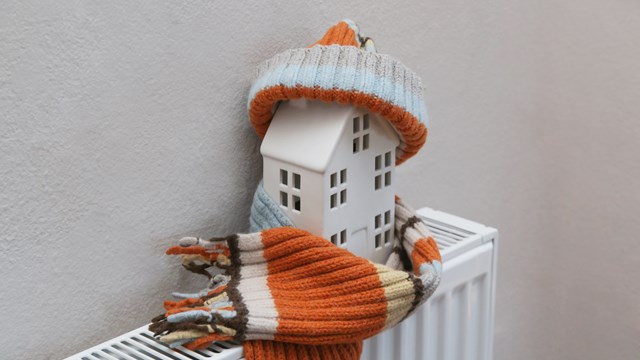
It’s a very special formula, says Ralph Noblin of the professional engineering firm Noblin & Associates. In New England, we literally went close to 20 years without that formula coming together. As a decades-long veteran of condo engineering, the Bridgewater-based Noblin has seen that formula—heavy snow and little wind followed by sustained cold temperatures—converge many times. And when the proper ingredients do combine, they all add up to ice damming—a costly headache for condo boards, property managers, and even unit owners themselves.
Basically, an ice dam is a ridge of ice that builds up along the edge of a roof. The ice creates a dam that backs water up and under the roof shingles.
“The fundamental problem,” says Noblin, “is that when the attic is warmer than the outside temperature, the attic is warm enough to start melting the snow.” From there, the newly-liquified water flows beneath the rooftop snow layer, eventually gliding to the roof’s edge. Upon reaching the overhang, the ambient freezing temperature returns the water to a solid state. And it is this insidious freeze-thaw cycle that begets the formation of an ice dam, a time-sensitive problem that can quickly lead to costly water damage.
For many property managers, the winter of 2010 was particularly problematic. “We were getting to be near one of the top ten years in snowfalls,” says Irene Morrill of the Massachusetts Institute of Insurance Agents. “We pretty much had a lot of snow—one storm after another—and then it was cold and never got to really effectively melt off the roof. You get a lot of snow, and then the heat from inside the buildings rises. And it’s cold outside but warm underneath. And it melts and thaws, melts and thaws. A few years ago—could have been ten years ago now, there was a worse time—but last year was pretty bad.”
Although ice damming is a potential issue for many structures in a cold-weather climate, the problem is often more severe with condo properties. “When architects design condominiums, the last thing they want it to look like is a big commercial warehouse-type structure. They want it to be soft, to be aesthetically-pleasing, to be attractive,” says Noblin. “They’ll introduce dormers and valleys and different things up on the roof. And they’re what we call snow-catchers.”
“Ice dams don’t happen on flat roofs,” reminds Bernie Gitlin, president of Global Insurance Network in Needham, Massachusetts. “So if you’ve got a shingled roof that is peaked, [insurers] look at the roofline and the condition of the shingles.”
Fancifully-constructed rooflines, though aesthetically-pleasing to potential buyers, provide ongoing insurance liabilities for condo associations—the costliness of which may continue to increase if New Englanders see another harsh winter. “It can be nothing for five years or ten years, like it was, and then all of a sudden you get the right set of conditions,” says Gitlin. “2010 was the worst in many years. There were two years back in the ‘90s—‘94 and ‘96—when it was horrendous. At that point many insurance companies started to do some different things.”
Sensing a then-developing trend in condo insurance claims, New England insurers gradually began introducing the concept of per-unit ice dam deductibles—charges made to individual unit-owners based upon the damage totals for each single unit, not the overall amount for the condo property itself. “What happens with ice dams,” says Gitlin, “sometimes there’s a lot of damage in a particular unit. But, more often than not, it’s a small amount of damage—a stain on a wall or two, a stain on the ceiling. And they may have that same problem in fifty different units. So a number of the more-sophisticated insurance companies are beginning to say they want a $1,000 or $2,500 per-unit deductible. If the damage totaled a small amount, the unit owners would be responsible for that.”
Unlike other external maintenance issues, the insurance implications of ice damming are decidedly murky, often creating insurance claims that involve both the master policy and the individual policies of the unit owners affected. “It depends on how the bylaws of the association read,” says Morrill. “If the association chooses just to insure the common elements, it could be that both policies have to get involved.” And while some states do require associations to carry coverage for individual unit damages, this is not true throughout all of New England.
“At the very least, agents usually try to find out what the master policy deductible is and make sure their insurance carries that amount of coverage A.” And while such coverage levels are hardly foreign to mortgage holders who purchased their condo units in the wake of the housing bubble, unit owners without mortgages may well be underinsured against such damage. In some cases, explains Morrill, they may not be insured for it at all. “It might not be included under a unit owner policy if they don’t have all-risk or open perils,” she says. “I just suggest that people make sure that on their HO6—their condo unit-owner policy—they have open-peril coverage and they buy a certain amount of coverage A. They need to know what the master policy deductible is. That they need to know. Because it’s nice that the association chose to cover my unit—but if they have a $25,000 deductible and the loss is mostly in my unit, that will be an ugly situation!”
Considering the complicated and potentially-contentious insurance implications of ice dam-related leaks, the importance of preventing ice damming can hardly be overstated. “In a perfect world, a property manager would be inspecting his buildings on a daily basis,” says Noblin. “If that perfect storm exists, after the first couple of days, the property manager looks up and sees this consistent line of ice running across the front of the building [that] has liquid water behind it. That water is coming up against a shingled roof. And, at getting under shingles, liquid water does not have a problem.”
When management spots an ice dam formation, the attempted remedy must be made very quickly. Yet managers have decidedly few options in the wake of this frosty menace. The first option—and by far the trickiest—is attempting to clear snow from a property’s roofline through the use of so-called “roof rakes.” “In cold temps,” says Noblin, “asphalt roof shingles are very brittle, almost like panes of glass. Picture trying to shovel snow off panes of glass, and trying to do it from twenty feet over your head. If you look at a hundred roofs that have been raked, probably seventy-five or more are going to be damaged to some extent.”
The second option for property managers is the installation of traditional heat tape—flexible electric heating elements that would likely be in place before the snowfall ever began. “Beyond those two,” says Noblin, “there’s not much else you can do. The longer nothing is done, the worse the condition gets. It’s very time-sensitive.”
Ironically, the most effective methods for combatting the dreaded ice dams are steps that must be taken long before the event ever occurs—before the condo is even roofed. Designing proper attic ventilation—the kind that prevents temperature inequities between the attic and outside air—is a key step in constructing a roofline that’s resistant to ice damming. The second construction-based method is the installation of a water-resistant roofing underlayment, which can seal out pooling water that collects behind an ice dam. The most common such product, Grace Ice and Water Shield—what Noblin calls “the Coca-Cola” of roofing underlayment—was first introduced into the marketplace nearly thirty years ago. Yet experts say many condo properties still lack this shielding in sufficient amounts. “In theory, it seals around all the nails used to attach the shingles,” Noblin explains. “If that material is not present, or is not present in enough quantities, you’re going to have a problem.”
Building codes vary by jurisdiction, but most recently-roofed condos are likely to have an underlayment stretching at least three feet from the edge of the overhang. Yet, in the light of recent weather patterns, such three-foot strips are hardly adequate. “Those amounts will be reviewed or probably increased,” says Noblin. “It’ll take them awhile; instead of a three-foot wide strip, we probably need six or nine.”
“Sometimes there’s nothing you can do to avoid [damage] unless you have ice shield running half-way up the roof,” says Gitlin. “I think the associations have got to be aggressive about trying to prevent this damage by maintaining their roof properly. And that’s often a hard thing to do, because it costs money. Associations don’t like to spend money these days.”
Matthew Worley is a freelance writer and a frequent contributor to New England Condominium.






Leave a Comment